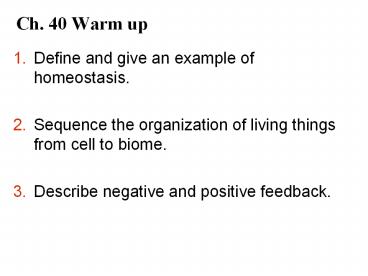Ch. 40 Warm up PowerPoint PPT Presentation
1 / 27
Title: Ch. 40 Warm up
1
Ch. 40 Warm up
- Define and give an example of homeostasis.
- Sequence the organization of living things from
cell to biome. - Describe negative and positive feedback.
2
Chapter 40
Basic Principles of Animal Form and Function
3
Overview Diverse Forms, Common Challenges
- Anatomy the study of the biological form
(STRUCTURE) of an organism - Physiology the study of the biological FUNCTIONS
an organism performs - Structure dictates function!
4
Figure 40.1
5
Animal form and function are correlated at all
levels of organization
- Size and shape affect the way an animal interacts
with its environment - Many different animal body plans have evolved and
are determined by the genome
6
Hierarchical Organization of Body Plans
- Cells ? Tissues ? Organs ? Organ Systems
7
Four main types of tissues
- Epithelial covers the outside of the body and
lines the organs and cavities within the body - Connective binds and supports other tissues
(cartilage, tendons, ligaments, bone, blood,
adipose) - Muscle controls body movement (skeletal, smooth,
cardiac) - Nervous senses stimuli and transmits signals
throughout the animal (neurons, glia)
8
(No Transcript)
9
(No Transcript)
10
(No Transcript)
11
(No Transcript)
12
Coordination and Control Within a Body
- Endocrine system transmits chemical signals
(hormones) to receptive cells throughout body via
blood - Slow acting, long-lasting effects
- Nervous system neurons transmit info between
specific locations - Very fast!
- Info received by neurons, muscle cells,
endocrine cells
13
(No Transcript)
14
Homeostasis
- Maintain a steady state or internal balance
regardless of external environment - Fluctuations above/below a set point serve as a
stimulus these are detected by a sensor and
trigger a response - The response returns the variable to the set
point
15
(No Transcript)
16
- Negative Feedback
- Positive Feedback
- More gets you less.
- Return changing conditions back to set point
- Examples
- Temperature
- Blood glucose levels
- Blood pH
- Plants response to water limitations
- More gets you more.
- Response moves variable further away from set
point - Stimulus amplifies a response
- Examples
- Lactation in mammals
- Onset of labor in childbirth
- Plants ripening of fruit
17
(No Transcript)
18
Thermoregulation
- Maintain an internal temperature within a
tolerable range - Endothermic animals generate heat by metabolism
(birds and mammals) - Ectothermic animals gain heat from external
sources (invertebrates, fishes, amphibians, and
nonavian reptiles) - Q Which is more active at greater temperature
variations? - Q Which requires more energy?
19
Figure 40.10
20
Balancing Heat Loss and Gain
- Organisms exchange heat by four physical
processes radiation, evaporation, convection,
and conduction
21
- Five adaptations for thermoregulation
- Insulation (skin, feather, fur, blubber)
- Circulatory adaptations (countercurrent exchange)
- Cooling by evaporative heat loss (sweat)
- Behavioral responses (shivering)
- Adjusting metabolic heat production (antifreeze)
22
Figure 40.12
23
Figure 40.16
24
Energy Use
- Metabolic rate amount of energy an animal uses
in a unit of time - Basal metabolic rate (BMR) endotherm at rest at
a comfortable temperature - Standard metabolic rate (SMR) ectotherm at rest
at a specific temperature - Ectotherms have much lower metabolic rates than
endotherms of a comparable size
25
Figure 40.19
26
Torpor and Energy Conservation
- Torpor is a physiological state in which activity
is low and metabolism decreases - Save energy while avoiding difficult and
dangerous conditions - Hibernation torpor during winter cold and food
scarcity - Estivation summer torpor, survive long periods
of high temperatures and scarce water
27
(No Transcript)

